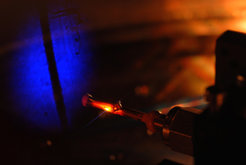Ultrafast Ultraviolet Pulse Generation
Project leader: Prof. Dr. Reinhard Kienberger
Project coordinator from King Saud University: Prof. Dr. Abdallah Azzeer
Intense ultrashort laser pulses comprising merely a few field oscillation cycles at the border of the visible/near-infrared spectral range (at wavelengths around 800 nm) have been available for a number of years and have dramatically pushed the frontiers of nonlinear optics. Extending the technical capability of generating intense, near-single-cycle waveforms to the ultraviolet or (near) infrared spectral ranges would open up a number of exciting research opportunities. This project pursues the former objective by harmonic generation in high-density noble gases driven by ultra-intense 800-nm-wavelength few-cycle laser pulses.

Harmonic generation in nonlinear crystals has proved a powerful technique for converting coherent pulsed laser radiation from the visible and near-infrared into the ultraviolet spectral range. The requirement of equal phase velocity of fundamental and harmonic waves has limited efficient conversion to the near ultraviolet and pulses consisting of several or more wave cycles. In this project high-density noble gases are used instead of crystals as the nonlinear medium, which offer several distinct advantages including low dispersion, high damage (i.e. ionization) threshold and adjustable material density, and generate odd harmonics of intense, near-single-cycle, sub-4-fs, 750-nm-wavelength laser pulses. Generation of the third-, fifth-, seventh-, ninth-order harmonics and possibly beyond offers the potential for producing deep- to extreme-ultraviolet light pulses with unprecedented durations. They may lead to the first high-intensity pulses approaching the 1-femtosecond frontier.
Intense few-femtosecond light pulses in the deep ultraviolet and extreme ultraviolet spectral range opens, for the first time, the door for creating electron wave packets on molecular orbitals and drive their motion with the strong electric field of few-cycle waves of laser light. This constitutes an entirely new approach to coherent control of molecular processes and chemical reactions.
